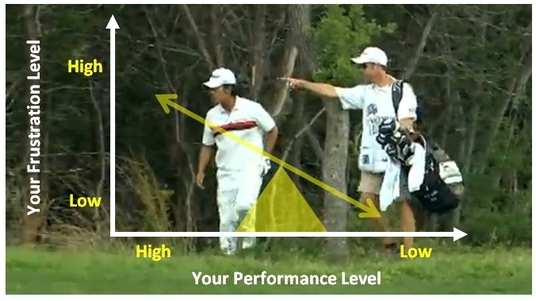|
What do you do when your golf game goes off the grid? You’ve been playing some great golf and shooting some excellent golf scores but for no apparent reason your game starts to turn on you; as your golf score average starts to climb your confidence level starts to decline. Well, for many professional golfers and elite amateur golfers the answer is quite interesting. You see the approach you take to getting your game back on track may also lead to your downfall... That’s right, history shows that many golfers who tried to get their game back to where it was, didn’t and sadly they never got close to the standard they used to enjoy. My business partner David Milne and I have known way too many elite amateur and professional golfers over the years who have reached a stage in their golf development where they quite honestly don’t know what to do to get better. Whether they stopped improving or started to play poorly the outcome for many was the same in many cases. They got a lot worse!... Do You Hit the Panic Button?  When elite golfers see their golf scores climb higher for an extended period they can get themselves into a mental state which can lead them down a well trodden pathway taking their game from bad to much worse. Instead of focusing on the reason why the high score average has increased they start to panic and search for reasons why they're not playing as well as they used. At Pro Tour Golf College we call this inferior problem solving strategy: The Panic - React and Try Strategy. The Panic - React and Try Strategy The Panic-React and Try strategy is an approach used by many elite golfers who have been struggling to get their golf to become more performance responsive. We have observed that these golfers tend to hit the panic button when their game starts to go off-track and as a result they become more reactive to their poor performances which forces them to try to find a different method/s, a different teacher, a DVD, a book or anything else in a desperate attempt to improve the direction of their game. As performances go down, their frustration level goes up and leads them to make drastic and unnecessary changes to their game. We estimate (in our experience) that more than 90 percent of elite golfers use this type of strategy and it usually leads to a high rate of failure and sadly many elite golfers leaving the game. Be Careful Not to Grow Rabbit Ears...  What's That You Say? What's That You Say? The panic-react and try strategy is quite prevalent on the professional golf tours where struggling tour golfers tend to ‘grow rabbit ears’ and start listening to the many well meaning types who hang around the professional golf tours in the hope of picking up a struggling golfer on which to work their magic. These golfers if they’re not careful can destroy any chance they have of getting their game back on track usually by going down the path of changing their golf swing. This tends to be one of the most common reactions of tour golfers and elite amateurs. And since more than ninety percent of golf teaching professionals work predominantly on golf swing technique it is highly unlikely that many of the struggling tour golfers will find a solution outside of the improve-the-golf-swing approach. Fortunately a small percentage of struggling elite amateur golfers and a growing list of professional golfers are going to sports psychologists and peak performance experts to help them to get their game back on track. The Elite Golfer Performance Paradox Consider that the golf swing that got you to the heights of the game is the very same one that you want to dismantle and put back together another way. It doesn't make sense, but then again there isn't much that is logical about golf and the way it is learned and played primarily because it is driven mostly by an emotion engine. And when negative emotion is running high, it influences negative logical thought, which is when we tend to make our worst decisions. Of course you might be thinking that this is a normal part of the learning process and you would be right. Learning and improving golf skills has continual ups and downs, and in-fact many more downs than ups. But having said that it is important to recognize the negative effect that your negative emotions are having on your thinking. There's a Better and Much Simpler Way...  If you are struggling with your game and starting to listen to the minions in and around golf, instead of your your inner voice of positive experience, then try this simple and elegant 4 step strategy to get you back on track. This is what we do when students first arrive at Pro Tour Golf College with a well practiced panic-react and try strategy. We apply the Stop-Think-Focus-Act strategy to help them get their confidence soaring and their golf scores under control 1. STOP FEEDING THE PROBLEM - YOU WILL REAP WHAT YOU SOW Firstly we have to STOP the chatter going on in their head and we do this by explaining that as long as they talk about their problem it will stay with them and get stronger. Paying attention to the problem of not playing well and discussing it with everyone around you will not rid you of it. All it does is makes it much worse. So what you should do is STOP talking about the problem NOW and whenever the subject is brought up (not by you) you talk about something else. STOP feeding it and it will die. If you start going into the negative chatter state just shout loudly STOP!  2. THINK ABOUT YOUR PAST SUCCESSES Now this is important; replace your negative chatter with a sequence of positive memories of past performances in the different areas of your golf game where you were very successful. From tee shots to pitch shots to putts made create a consistent series of positive memories to get you feeling more confident. Think about certain shots you played and the feelings associated with these thoughts. Do this everyday for a minimum of fifteen minutes and with as much detail (clarity) as you can imagine. See the shot, feel the stroke you made and listen to the sound of the golf ball leaving the clubface. Also imagine the positive comments from those who care about you. 3. FOCUS ON THE OUTCOMES YOU WANT Before you build a bridge you have to determine what it will look like and how it will work. You can build any old bridge, but the best one is the one that gets you from where you are to where you want to go quickly and efficiently. To build a great process you need a great outcome, and by getting into real detail about exactly what you want going forward you will start to develop a belief in your vision. Every great golfer has a very clear idea of what they want to achieve in the short to long term and you're no different. What is is that you truly want? Start with a small goal like hitting a certain amount of fairways from the tee or something similar. Get very specific about what you want to achieve and it will be easier to do.  4. ACT WITH PASSION AND A POSITIVE ATTITUDE ALWAYS When you go to work on achieving your outcomes do it like there's no tomorrow. Don't be casual about it, do it like it really matters to you. We have found that elite golfers who are passionate about achieving successful outcomes are much more likely to realize them. You'll have days where you'll be challenged, but don't let that stop you from getting to your outcomes. Golf is truly a game that exploits your weaknesses and every golfer has them. The key is to keep plugging away at getting better. Focus on your outcomes and build the best process possible that allows you to tap into your well developed skills that you have spent your lifetime learning. Don't reinvent the wheel, you already know how to play golf, so get out of your own way and start playing again just like you used to. Everything you have learned from golf resides inside you and the last thing you want to do is change what you're doing. You already have all the resources you need to get your game back on track and to take it from there to levels never before experienced. Believe in yourself and your ability by taking responsibility to become the golfer you truly want to be. Lawrie Montague and David Milne - Pro Tour Golf College Comments are closed.
|
Archives
June 2019
|
Proudly Supported By
Copyright © 2011 - 2018 Pro Tour Golf College
Website Managed By Golf Performance Media
All Rights Reserved
Website Managed By Golf Performance Media
All Rights Reserved



 RSS Feed
RSS Feed



